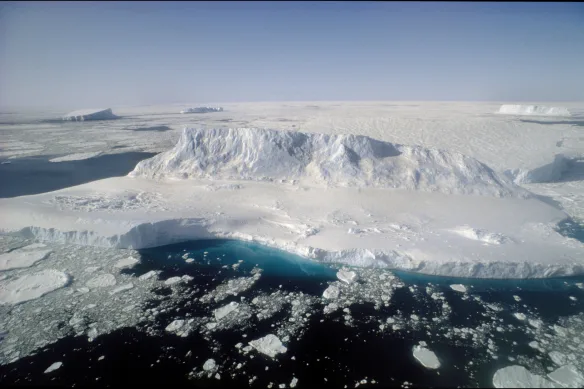
Record low Antarctic sea ice in recent years may be a sign the region has entered a “new regime” of low sea ice coverage driven by warming, research suggests.
The study, conducted by Australian scientists, describes a “breakdown” in the link between sea ice and the atmosphere over Antarctica. It suggests that the area may have “entered a new regime in which previously important relationships no longer dominate sea ice variability”.
‘Something weird is going on’: search for answers as Antarctic sea ice stays at historic lows“While for many years Antarctic sea ice increased despite increasing global temperatures, it appears that we may now be seeing the inevitable decline, long projected by climate models,” the study found.
Scientists say the “regime shift” in sea ice coverage will likely have far-reaching repercussions for both local Antarctic ecosystems and the global climate system.
“Over the past seven summers there have been three record [sea ice] minimums,” said the study’s lead author, Dr Ariaan Purich of Monash University and the Securing Antarctica’s Environmental Future program.
Antarctic sea ice had increased over multiple decades to peak in 2014, before transitioning to a low sea ice state in mid-2016.
A minimum record set in February 2022 was broken this year on 19 February, when Antarctic sea ice was observed to cover 1.77m sq km – 36% less than the 1979-2022 daily minimum sea ice coverage.
“In 2022 and again this summer, the hemispheric winds [linked to a positive phase of the southern annular mode] suggested there should have been higher-than-usual sea ice, and yet we had two record low sea ice summers,” Purich said. “Sea ice doesn’t seem to be responding to the atmosphere in the same way that it used to … suggesting something else is at play.”
The researchers identified that subsurface warming of the Southern Ocean was closely linked to sea ice loss.
“We’ve found that the ocean – particularly 100-200m below the surface – started warming really noticeably a year or two before we saw this change in the sea ice system, and has stayed warm ever since,” said study co-author Dr Edward Doddridge from the Australian Antarctic Program Partnership at the University of Tasmania. “The sea ice loss lined up with areas where warming happened most.”
Australian government backflips on cancellation of Antarctica penguin surveys
The researchers cannot entirely rule out the possibility that the trend in recent years is the result of natural variability in the Antarctic sea ice system, given that the satellite record of the continent only began in 1979.
“While variability may be contributing in some part to the current subsurface ocean warming, we also know that increasing greenhouse gases and increasing temperatures are also contributing,” Purich said.
“The thing that is really confronting is that this decline continues. We’re not at some record low now that we’re going to stay at. If we keep increasing greenhouse gas [emissions], the models tell us the sea ice is going to keep declining further.”
The sea ice decline is likely to affect Antarctic species such as krill, a foundational species in the Southern Ocean food web, as well as animals that live on the ice, such as Weddell and crabeater seals. Thousands of emperor penguin chicks are believed to have died last summer due to the break-up of usually stable sea ice at a time when the chicks had not yet grown their waterproof feathers.
Antarctic sea ice also plays a key role in a deep ocean current known as the Southern Ocean overturning circulation. “This influences how the ocean uptakes heat and carbon,” Purich said.
Prof Matthew England, an oceanographer and climate scientist at the University of New South Wales who was not involved in the study, agreed that ocean warming was the likely primary culprit.
He said the loss of Antarctic sea ice was concerning for two reasons. First because it provides a protecting buffer for ice shelves and so its loss exposes those shelves and amplifies sea level rises.
Second is that losing sea ice increases the area of dark ocean that absorbs energy from the sun, again resulting in an amplifying feedback loop.
“If we lose Antarctic sea ice we lose that reflectivity, and so you get more ocean warming,” England said.
“The knock-on effects to losing sea ice are profound.”
The study was published in the journal Communications Earth & Environment.






